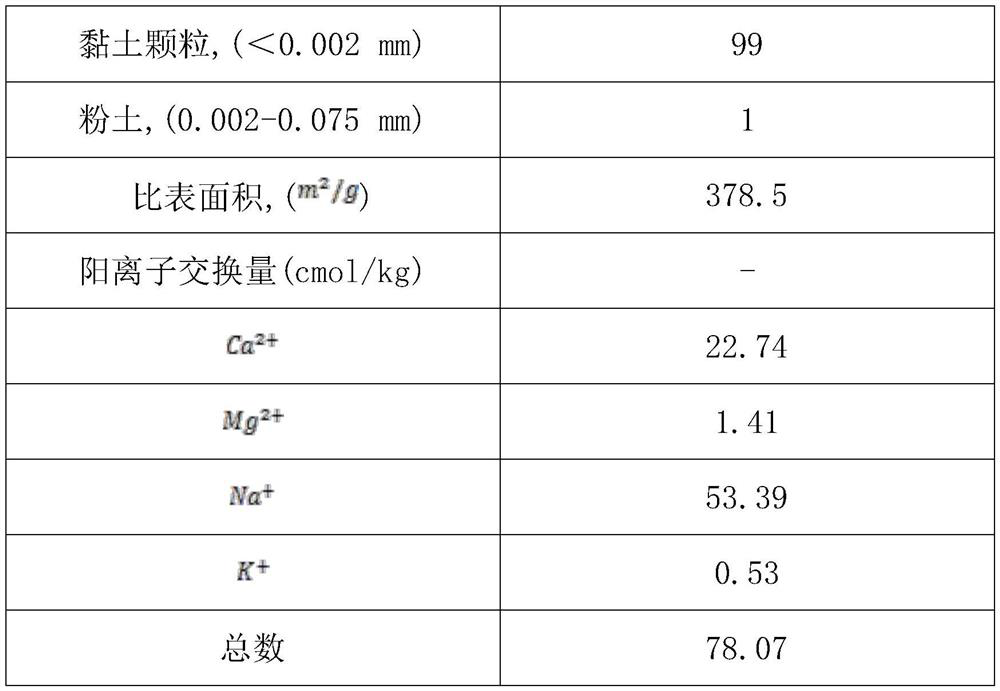A heat-insulating and anti-cracking vertical barrier material for complex pollutants and its preparation method
A technology of anti-cracking and pollutants, which is applied in the field of isolation and control of contaminated sites, can solve the problems of barrier barrier failure, thermal diffusion, and increase in permeability coefficient, and achieve high thermal insulation function, good chemical compatibility, and enhanced treatment effect.
- Summary
- Abstract
- Description
- Claims
- Application Information
AI Technical Summary
Problems solved by technology
Method used
Image
Examples
Embodiment 1
[0054] Step 1) dissolving cetyltrimethylammonium bromide in distilled water, adding attapulgite, keeping the mass ratio of the two at 1:9, to obtain a suspension;
[0055] Step 2) Keep the suspension prepared in step 1) at a constant temperature at 30°C, use an electric mixer, keep the rotation speed at 200r / min, and continue stirring for 12h to obtain the suspension;
[0056] Step 3) Centrifuge the suspension prepared in step 2) at a speed of 2000r / min for 30min, pour out the supernatant, wash the residue with distilled water, and then centrifuge again. After repeating this operation 3 times, a solid product is obtained ;
[0057] Step 4) drying the solid product obtained in step 3) at 105° C. for 12 hours to obtain a sample;
[0058] Step 5) Grinding the dried sample in step 4) to 200 mesh to obtain an organically modified attapulgite, and then placing it in an oven at 60°C for later use;
[0059] Step 6) adding the treated organically modified attapulgite into the sodium-...
Embodiment 2
[0067] Step 1) dissolving cetyltrimethylammonium bromide in distilled water, adding attapulgite, keeping the mass ratio of the two at 1:9, to obtain a suspension;
[0068] Step 2) Keep the suspension prepared in step 1) at a constant temperature at 35°C, use an electric mixer, keep the rotation speed at 500r / min, and continue stirring for 24h to obtain the suspension;
[0069] Step 3) centrifuge the suspension prepared in step 2) at a speed of 4000r / min for 60min, pour out the supernatant, wash the residue with distilled water, and then centrifuge again. After repeating this operation 6 times, a solid product is obtained ;
[0070] Step 4) The solid product obtained in step 3) was dried at 105° C. for 24 hours to obtain a sample;
[0071] Step 5) Grinding the dried sample in step 4) to 300 mesh to obtain an organically modified attapulgite, and then placing it in an oven at 80° C. for subsequent use;
[0072] Step 6) adding the treated organically modified attapulgite into t...
Embodiment 3
[0080] Step 1) dissolving cetyltrimethylammonium bromide in distilled water, adding attapulgite, keeping the mass ratio of the two at 1:9, to obtain a suspension;
[0081] Step 2) Keep the suspension prepared in step 1) at a constant temperature at 30°C, use an electric mixer, keep the rotation speed at 200r / min, and continue stirring for 12h to obtain the suspension;
[0082] Step 3) Centrifuge the suspension prepared in step 2) at a speed of 2000r / min for 30min, pour out the supernatant, wash the residue with distilled water, and then centrifuge again. After repeating this operation 3 times, a solid product is obtained ;
[0083] Step 4) drying the solid product obtained in step 3) at 105° C. for 12 hours to obtain a sample;
[0084] Step 5) Grinding the dried sample in step 4) to 200 mesh to obtain an organically modified attapulgite, and then placing it in an oven at 60°C for later use;
[0085] Step 6) Add the treated organically modified attapulgite into the sodium-mod...
PUM
| Property | Measurement | Unit |
|---|---|---|
| particle diameter | aaaaa | aaaaa |
| specific surface area | aaaaa | aaaaa |
| particle diameter | aaaaa | aaaaa |
Abstract
Description
Claims
Application Information
 Login to View More
Login to View More - R&D
- Intellectual Property
- Life Sciences
- Materials
- Tech Scout
- Unparalleled Data Quality
- Higher Quality Content
- 60% Fewer Hallucinations
Browse by: Latest US Patents, China's latest patents, Technical Efficacy Thesaurus, Application Domain, Technology Topic, Popular Technical Reports.
© 2025 PatSnap. All rights reserved.Legal|Privacy policy|Modern Slavery Act Transparency Statement|Sitemap|About US| Contact US: help@patsnap.com



